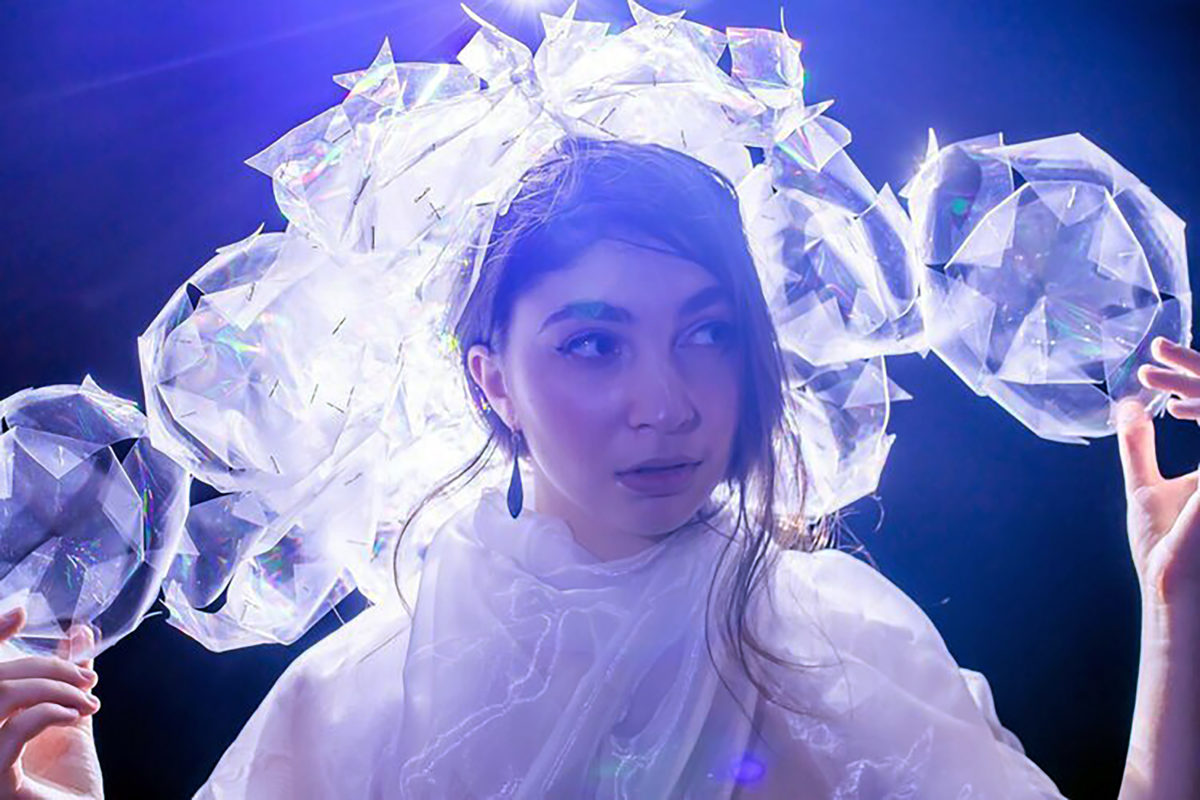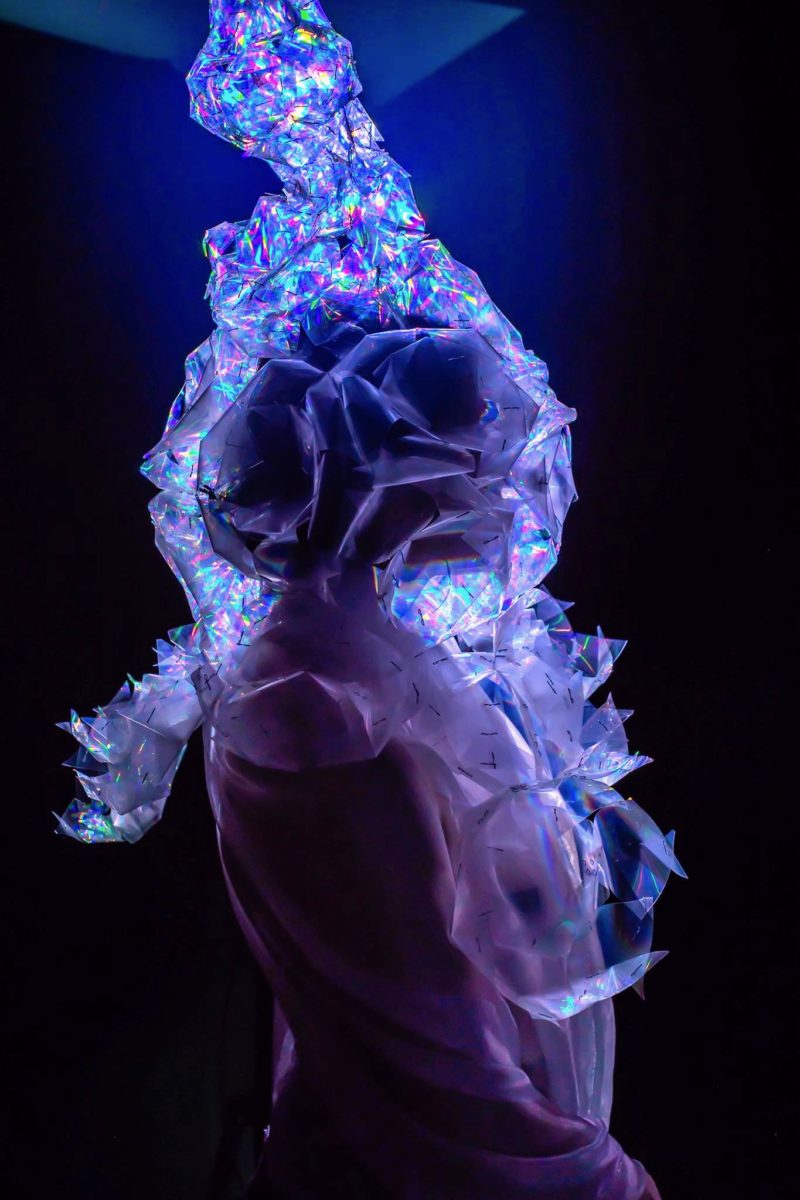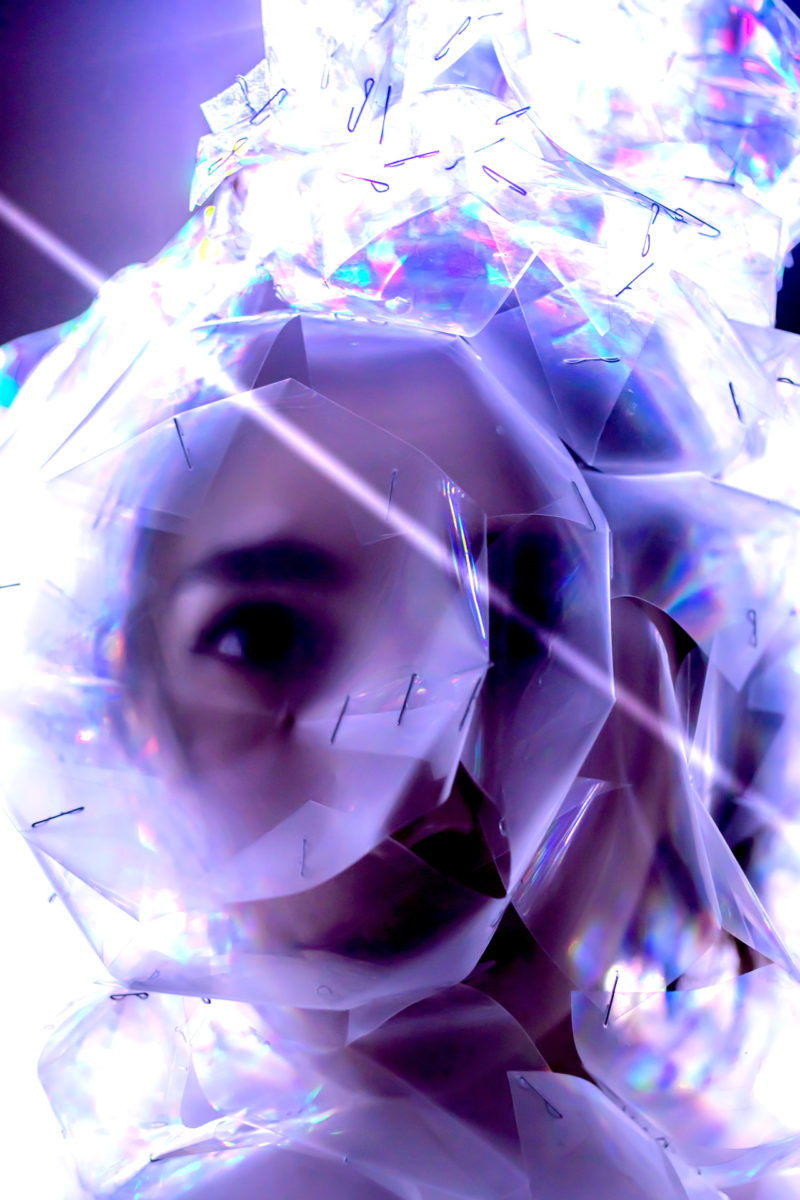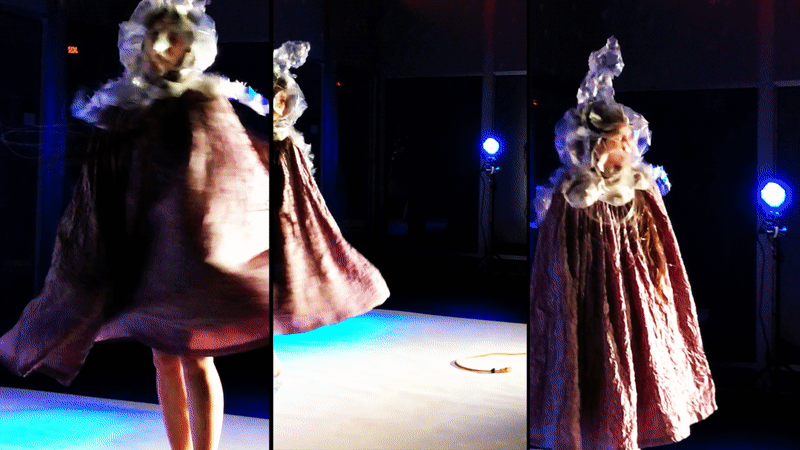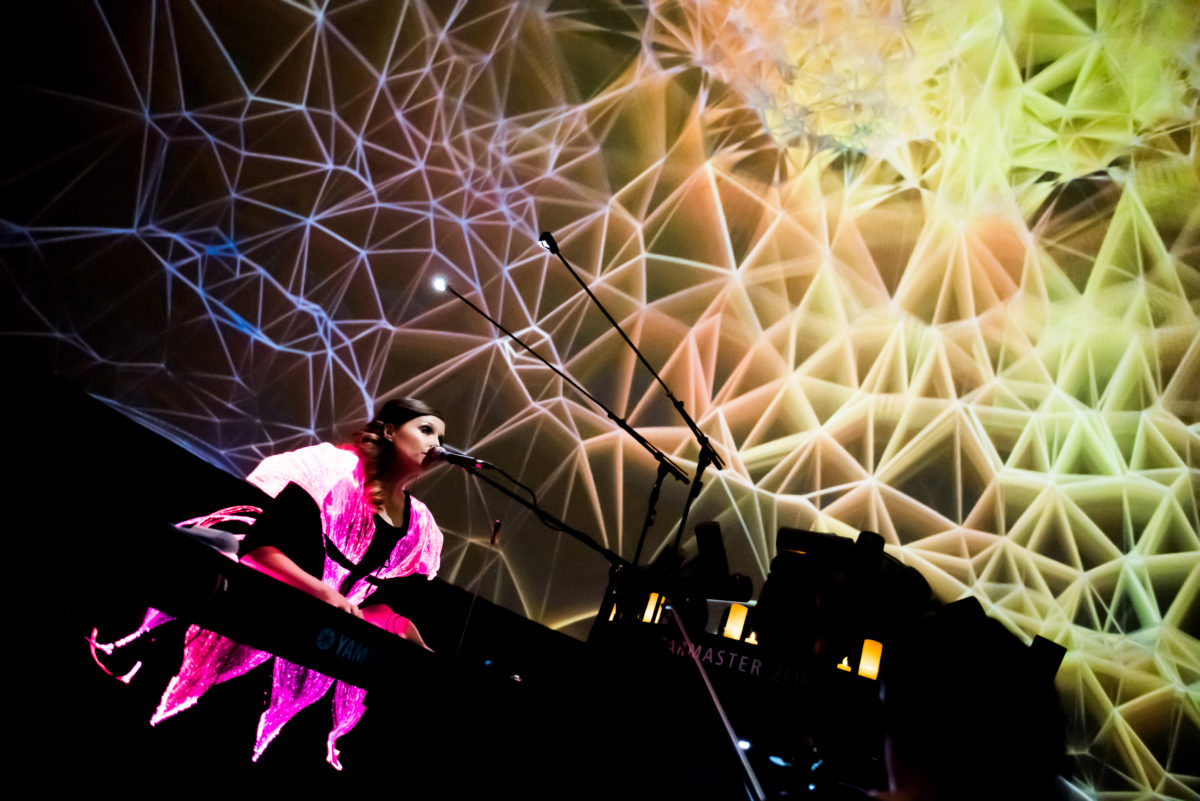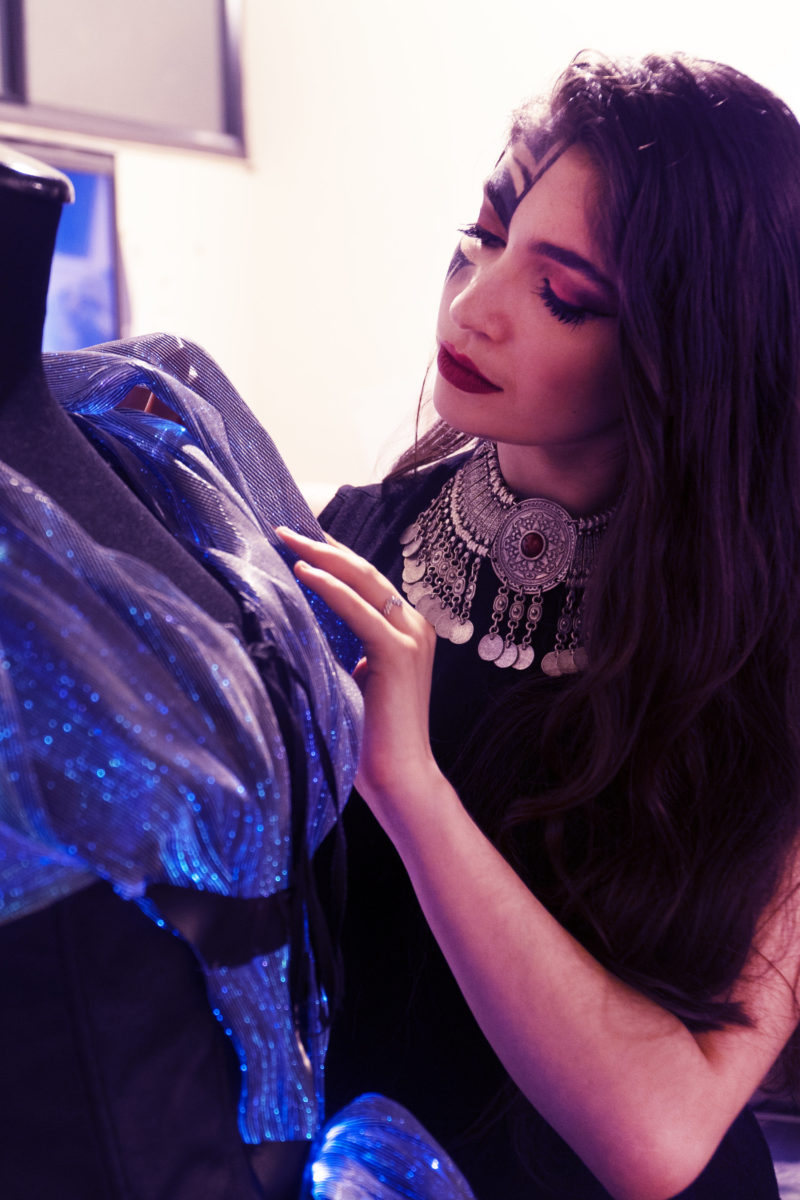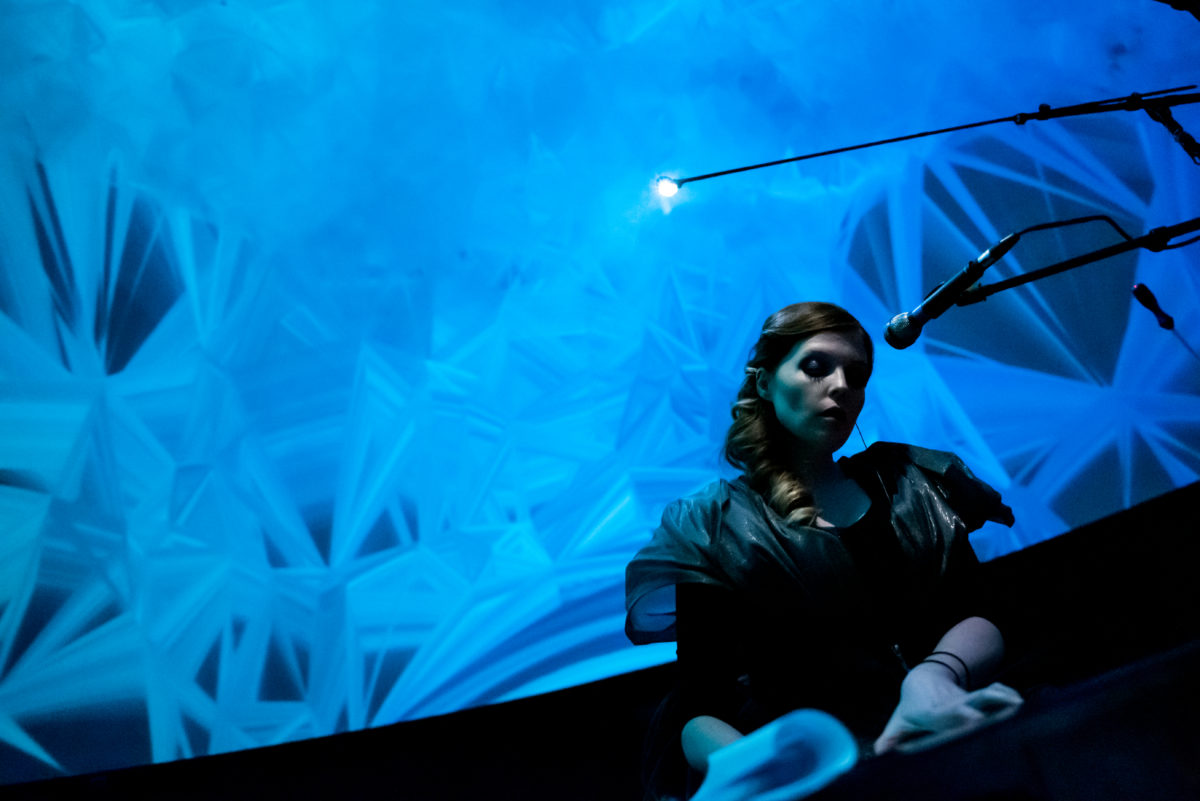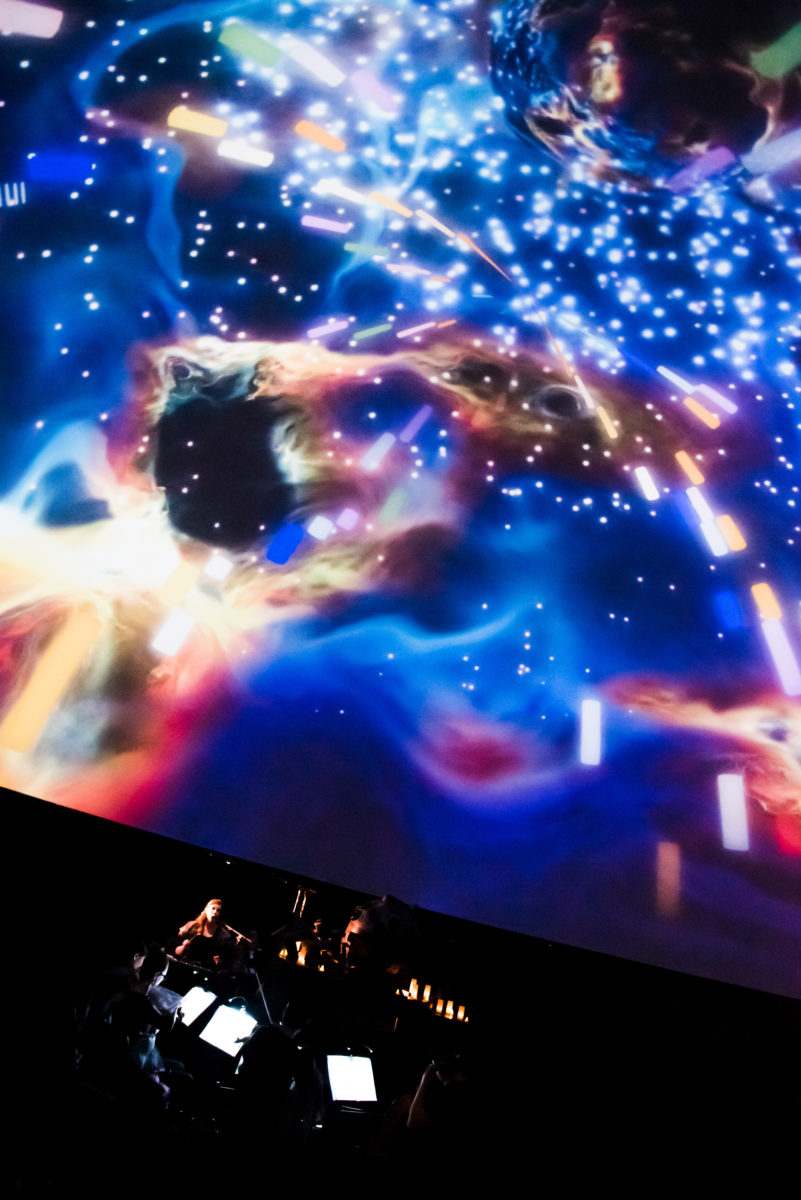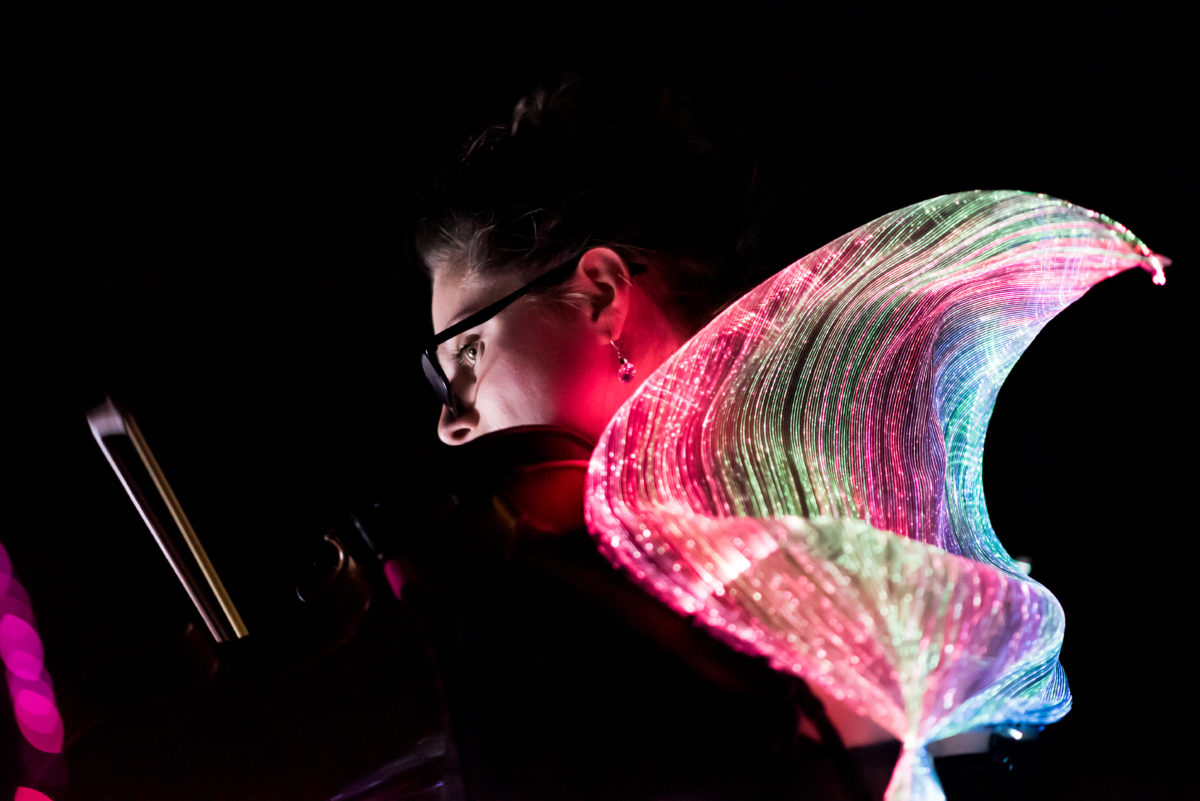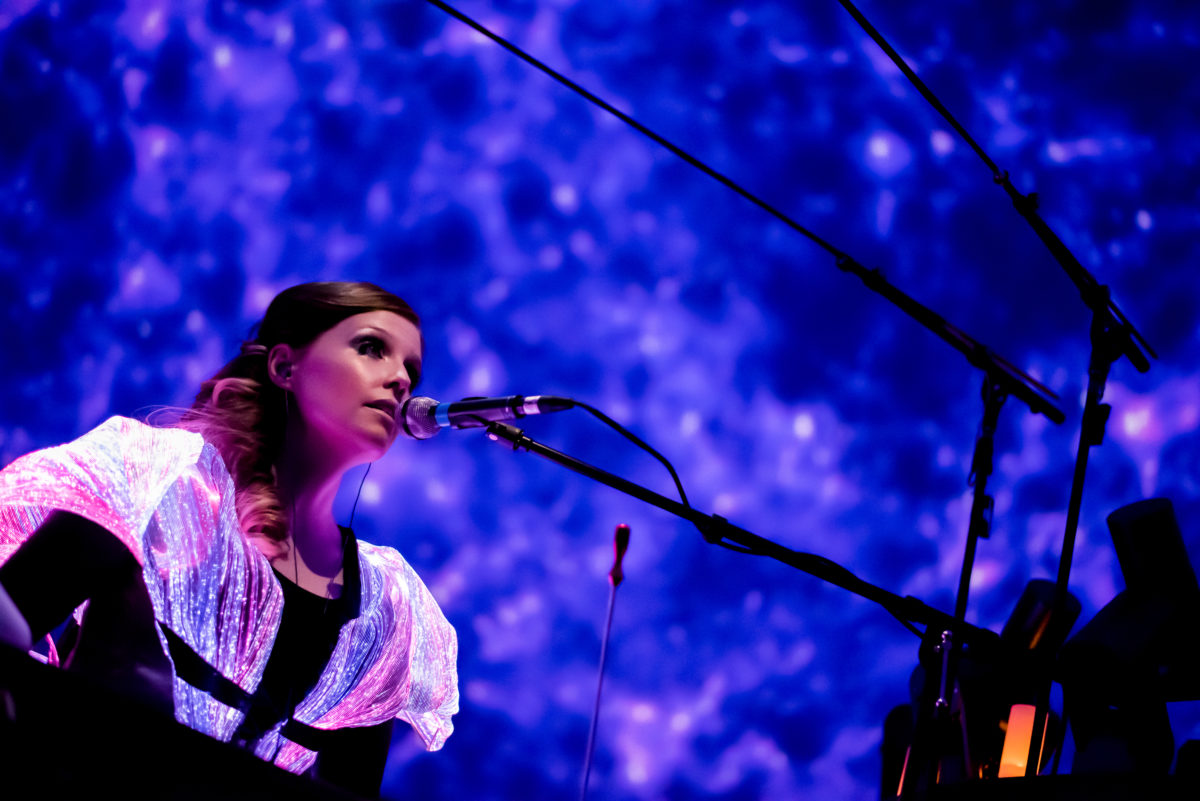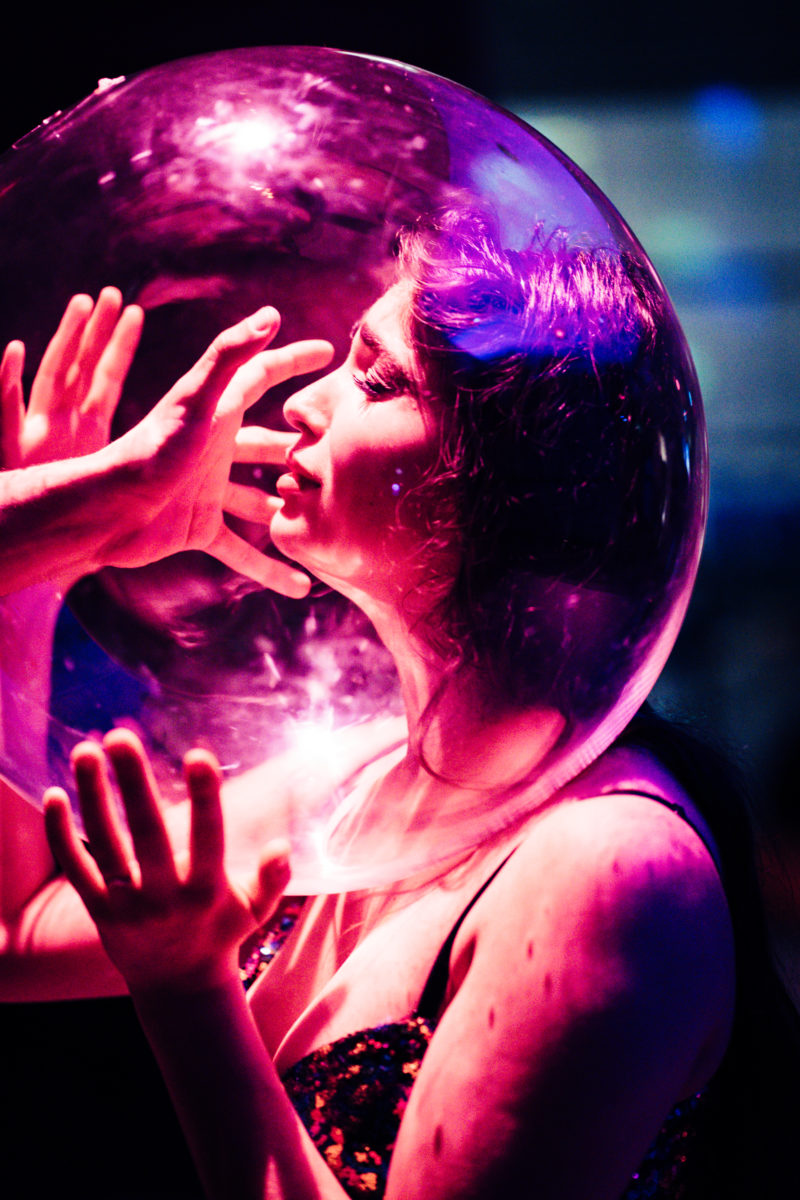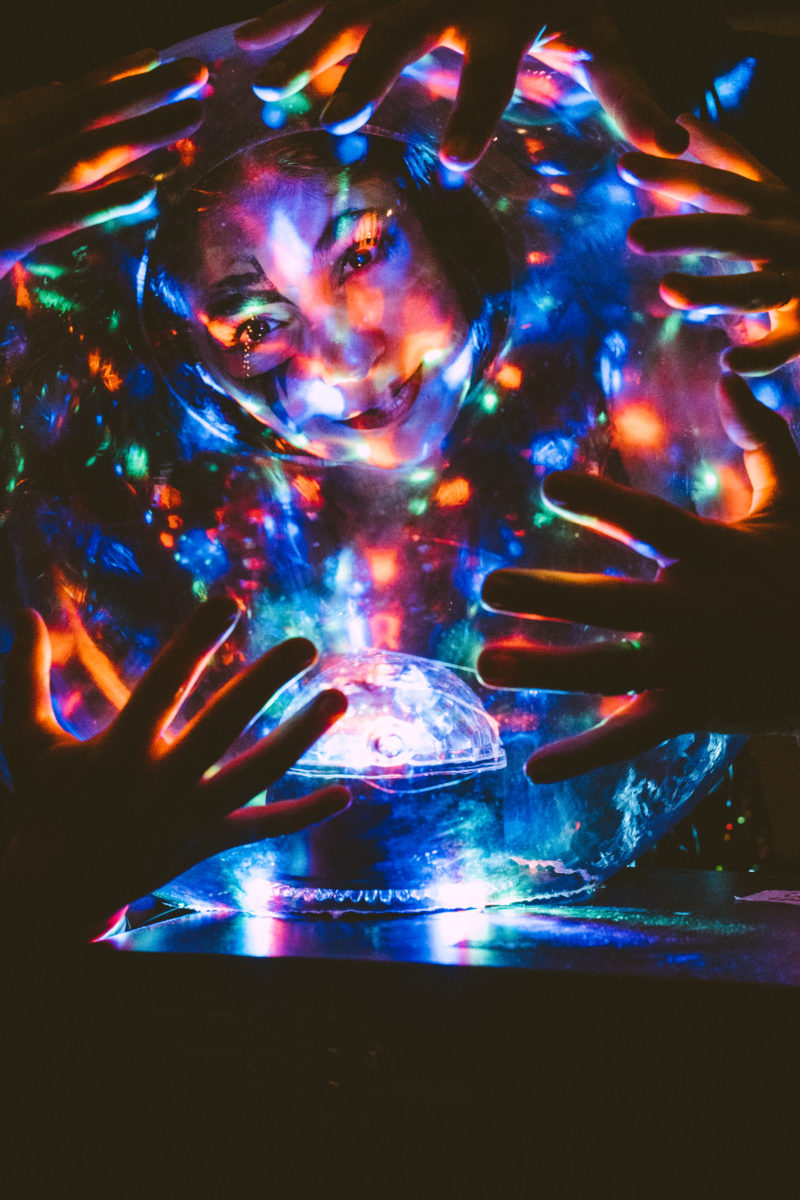← 2020 Schnitzer Prize in the Visual Arts
Siranush Babakhanova
Honorable Mention, 2020 Harold and Arlene Schnitzer Prize in the Visual Arts
More about the artist
Radiolarian
Optic fiber fabrics, acrylic rope molds, laser-cut black artificial leather, black tulle filling, diffraction grating acrylic, custom-made LED-Arduino system, iron staples, and organza. Each dress: 100cm x 100cm x 50cm; 3D hollow sphere: diameter 26.5m. 2019.
This psychedelic radiolarian experience consists of wearing a visual signal mask, observing the microscopic light-emitting sources, and feeling the effects of the sensory deprivation suit. The portable facial architecture seamlessly attaches itself to a human head, providing a new visual and tactile paradigm of experiences. The optical characteristics of the diffraction acrylic grating mask become a versatile tool for creation of all sorts of visual illusions. The convoluted reflective and semi-transparent fabric around the main tactile centers of bodies and hands further stresses the importance of touch, which many other organisms lack.
Radiolarian is a celebratory attire crowning the human body for its amazing perceptive abilities. However, it is also a depriving and psychedelic ritual attire, exemplifying that, while we did break away from the imprisonment of deep oceans, unicelularity, and a lack of sensory organs, we are still imprisoned in our bodies. In fact, however strong our brains are, while there are limited channels through which we can interact with the world, we will always converge within our explorations of the universe into mere undulations and rotations, and eventually realize that we are still not too far from our fellow radiolarians.
Neoperceptions
Optic fiber fabrics, acrylic rope molds, laser-cut black artificial leather, black tulle filling, custom-made LED-Arduino system, mastercode that translates audio information received by individual microphones into a LIVE regime. Each dress: 100cm x 100cm x 50cm. 2019.
Synesthesia is one of various ways brains can augment their information processing, allowing for richer experiences. In particular, audio visual synesthesia allows one to have involuntary experience of visual modality when hearing an audio input and vice versa. Through Neoperceptions, we created a live-performance technology that displays the real-time color patterns that a synesthetic composer associates with her music, allowing audience members to “hear” color and “see” sound just as synesthesia would allow them to experience. Neoperceptions allows connections in synesthetic mapping to be shared among those who do not have the biological capabilities for such an experience.
In order to display the various colors and impressions that a polymodal synesthete experiences when listening to music, both synesthesia-inspired visuals and special clothing were created for the quintet. 360-degree dome visuals were formed by the Museum of Science Boston’s award-winning planetarium team and Neoperception team (MIT Physics + Media Lab, advised by Physics Nobel Laureate Professor Frank Wilczek); sound-responsive, synesthesia-displaying LED garments: created by MIT’s Neoperceptions initiative; and HiLyghters: created by MIT and ASU SciHub teams.
Video: Lost, performed by Mary Bichner and Planetary Quartet during “Synesthesia Suite” at the Museum of Science Boston’s Charles Hayden Planetarium on April 4th, 2019.
Sponsored in part by Council for Arts at MIT.
Touch Me Not
50 x 50 x 50cm. Materials: Acrylic hollow sphere. 2020.
This photography project illustrates the narrative of Touch Me Not, a short story by S. Babakhanova, which in turn revolves around the exploration of others, personal surroundings, and self at the age of social distancing.
In three stages, it develops a philosophical monologue of the author’s evolution through different stages of self-isolation and deprivation of human interaction. In an attempt to develop a language between the sensory and mental experiences of self-isolation and biological and quantum-mechanical notions of interaction, Touch Me Not draws upon contemporary theories of the physical nature of the experience of interaction.
Redefining notions of love as “invasion of the other, mutual parasitism” it poses questions about self-containment. Inspired by timeless science fiction works, Touch Me Not concludes that the self-contained nature of our universe poses questions about the potential for contact between universes beyond ours and the simulated universes within each one of us.
About the Artist
Siranush Babakhanova is a multimedia artist, scientist, and engineer, creating physical and digital technologies for human augmentation.
Siranush is interested in innovative (cyber/bio) fashion design and implementation of novel materials and interfaces, creating new storytelling techniques (linguistic and semiotic) and mediums (oceanological), and making tools and experiences (choreographies, immersive environments) that help imagine the future of human experience.
Armenia-born technologist and creative of Russian, Georgian, and other descent, fourfold winner of International Science Olympiads in Astrophysics and Biology, and laureate of Presidential Award “Best Student” (Armenia), Siranush studied Physics and Computer Science at MIT as Solagian and Luys Presidential Scholar, and as the first undergraduate female from her country. She researched terraformation at NASA, and ways to read/non-invasively interact with microstructures in the brain at the MIT Synthetic Neurobiology lab as a SuperUROP. She is the co-founder of Xapiens, MITʼs human augmentation initiative, hosting hundreds in person and tens of thousands online for human enhancement symposia, and contributing to popular science literature (NEO.LIFE). Siranush took part in the MIT FoundHers initiative for women leaders in entrepreneurship and led the MIT Armenian Society, helping to relaunch MIT-Armenia educational programs and promote traditional art and local initiatives.
In parallel, she conglomerated the largest teams for fashion design and photography for MITʼs Infinite Magazine, and led and took part in a number of award-winning (National Geographic Grant, Council for Arts at MIT (CAMIT) Award, NASA BIG Idea Challenge 2nd Place, CAMIT Directorʼs Grant) art-meets-science collaborations. Her performances and exhibitions (solo and in collaboration) were hosted in National Academic Theatre of Opera and Ballet aft. Spendiaryan (Yerevan, Armenia), Georgian National Opera Theater (Tbilisi, Georgia), Museum of Science, MIT Museum, MIT List Visual Arts Center (Boston, US). In the fall of 2020, Siranush will be joining Stanford Biophysics PhD program as Knight-Hennessy Fellow, National Science Foundation Graduate Research Fellow, ADVANCE Program Fellow, Interact Fellow, and Hertz Graduate Fellowship Finalist.


